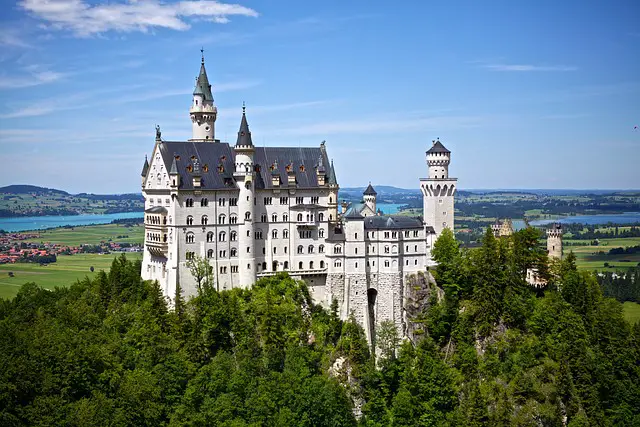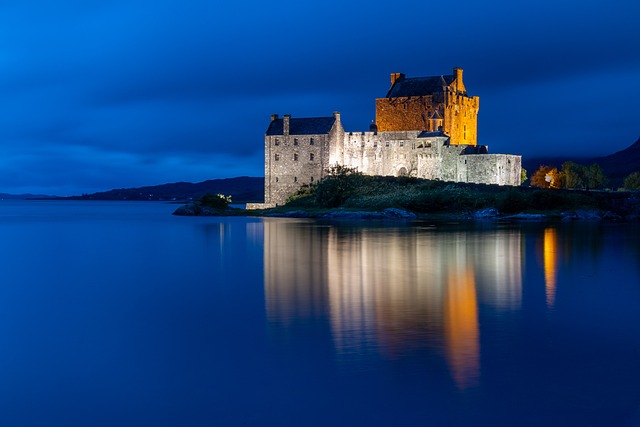Citadels are usually smaller than castles and are built to protect a city or town, while castles were built as homes for royalty and nobles. Citadels typically have stronger walls than castles, as they needed to be able to withstand attack from enemy forces. Castles often had moats and drawbridges for additional protection. Citadels were also built to be easily defended, with narrow streets and few windows so that attackers would have a difficult time getting inside.
Citadel
(Image by Adam Derewecki from Pixabay )

A citadel is a fortified structure that is designed to provide protection and defense against external threats. The term “citadel” comes from the Latin word “civitas,” meaning city, and was originally used to describe a fortified area within a larger city or town.
Historically, citadels were built in strategic locations such as hills, high ground, or near water sources, and were typically constructed using thick walls, towers, and other defensive features. Citadels were often used as military strongholds or as places of refuge during times of war or unrest.
Today, the term “citadel” is sometimes used metaphorically to describe a place or organization that is strongly fortified or well-protected, either physically or metaphorically. For example, a financial institution such as Citadel, which is known for its sophisticated security and risk management systems, might be described as a citadel of finance.
Castle
(Photo by Cederic Vandenberghe on Unsplash )

A castle is a type of fortified structure that was originally built for military defense and protection. Castles were typically constructed during the Middle Ages in Europe and other parts of the world and were designed to provide shelter and security for nobles and their families.
Castles were typically built on high ground, such as a hill or a cliff, and were surrounded by walls, moats, and other defensive features to prevent invasion. They often included towers, battlements, and other defensive features, such as arrow slits, murder holes, and drawbridges.
Inside the castle walls, there were living quarters for the lord and his family, as well as barracks, kitchens, stables, and other facilities for the castle’s garrison. Castles were often centers of economic activity as well, with surrounding towns and villages depending on them for protection and trade.
Today, many castles have been converted into tourist attractions or museums, and are popular destinations for visitors interested in history and architecture. Some castles are still occupied by nobles or members of the royal family, while others have been renovated and converted into hotels or private residences.
Difference between citadel and castle
The main difference between a citadel and a castle is their primary purpose and function. While both are fortified structures designed to provide protection and defense, they were built for different reasons and in different historical contexts.
A citadel was originally built to protect a city or town from external threats, such as invasion or siege. It was often built on high ground and included a garrison of soldiers, as well as storage facilities for food and weapons. The primary function of a citadel was to defend the city or town and provide a safe refuge for its inhabitants during times of war or unrest.
In contrast, a castle was built primarily as a residence for nobles or other wealthy individuals. While it also included defensive features, such as walls, towers, and battlements, its primary function was to provide a comfortable and secure living space for its inhabitants. Castles were often built in picturesque locations, such as hills or by rivers, and were centers of economic and cultural activity.
While there may be some overlap in the design and features of citadels and castles, the primary difference lies in their purpose and function. Citadels were built for military defense and protection of a city or town, while castles were built as residences for nobles and centers of economic and cultural activity.
What is difference between castle and fort?
Castles were designed to be more comfortable than forts. They typically had larger rooms, better ventilation, and more amenities. However, this also made them more expensive to build and maintain. Additionally, castles were usually built on high ground to make them easier to defend.
Forts, on the other hand, were designed with defense in mind first and foremost. They were usually smaller than castles and had fewer amenities. This made them less expensive to build and maintain, but also less comfortable to live in. Additionally, forts were often built in low-lying areas so that they would be more difficult for an enemy to attack.
What is the difference between a castle and a palace?
The main difference between a castle and a palace is their purpose and function. Castles were primarily built for military defense and protection during times of war, while palaces were built as residences for kings, queens, and other rulers.
Castles were fortified structures designed to withstand attacks and were often located in strategic locations such as hills, cliffs, or near water sources. They included defensive features such as walls, towers, and battlements, as well as living quarters for the castle’s garrison and their families.
In contrast, palaces were built as grand residences for rulers and their families. They were often located in urban centers and were designed to showcase the wealth and power of the ruling family. Palaces typically included lavish living quarters, reception halls, gardens, and other luxurious features.
While castles and palaces may share some architectural features, such as towers and turrets, the primary difference lies in their purpose and function. Castles were built for military defense and protection, while palaces were built as grand residences for rulers and their families.
What are the types of castles?
Castles have existed for centuries and have taken many forms throughout history. Here are some of the most common types of castles:
Motte and Bailey Castles: These were the earliest type of castles built in England after the Norman conquest. A motte and bailey castle consisted of a raised mound of earth (the motte) with a wooden or stone keep on top and a courtyard (the bailey) at the base of the mound enclosed by a wooden palisade or wall.
Concentric Castles: This type of castle was developed in the 12th and 13th centuries and was characterized by multiple layers of defensive walls and towers, with the inner walls being higher than the outer walls. The purpose was to create a series of obstacles for attackers to overcome, making it difficult to breach the castle’s defenses.
Curtain Wall Castles: This type of castle was built from the late 12th to the 14th century and consisted of a single, thick wall that surrounded the castle grounds. The wall would be reinforced with towers and arrow slits to provide better protection.
Square Keep Castles: This type of castle was developed in the 12th century and was characterized by a square or rectangular keep (a fortified tower) surrounded by walls and towers. This design provided greater protection against attackers than earlier castle designs.
Hilltop Castles: These were castles built on hilltops, providing natural defense against attackers. Hilltop castles were often smaller than other types of castles, and were primarily used as lookout posts and defensive positions.
Palace-Fortresses: This type of castle was popular in Europe during the Renaissance and was designed to serve both as a palace and a fortress. These castles were often decorated with lavish art and furnishings and were designed to be both beautiful and functional.
Tower Houses: This type of castle was built in Scotland and Ireland from the 14th to the 17th century and was characterized by a tall tower, usually four to five stories high, with thick walls and few windows. Tower houses were built for defensive purposes and were often used as family homes.
These are just a few examples of the many types of castles that have existed throughout history.
The advantages and disadvantages of a citadel over a castle
A citadel and a castle are both fortified structures designed for defensive purposes, but they differ in some ways. Here are some advantages and disadvantages of a citadel over a castle:
Advantages of a Citadel:
- Better protection: A citadel is typically built on high ground, giving it better protection against potential attackers. It often has multiple layers of fortifications, making it more difficult to breach.
- Larger size: A citadel is typically larger than a castle and can house a larger number of people, making it more suitable for long-term stays during a siege.
- Strategic location: A citadel is usually located at a strategic point, such as a city center or a major transportation hub, making it an important military and political asset.
Disadvantages of a Citadel:
- More expensive: Building a citadel is typically more expensive than building a castle, due to its larger size and more elaborate fortifications.
- Higher maintenance costs: A citadel requires more maintenance than a castle, due to its larger size and more complex design.
- More difficult to build: Building a citadel requires more resources and skilled labor than building a castle, making it a more challenging construction project.
Advantages of a Castle:
- Easier to build: A castle is typically easier and less expensive to build than a citadel, as it requires fewer resources and less skilled labor.
- More versatile: A castle can be used for a variety of purposes, such as a residence, a military base, or a prison.
- Easier to maintain: A castle is typically smaller and less complex than a citadel, making it easier to maintain and repair.
Disadvantages of a Castle:
- Less protection: A castle is typically built on lower ground, making it more vulnerable to attacks from higher ground. It may have fewer layers of fortifications than a citadel.
- Smaller size: A castle is typically smaller than a citadel and may not be able to house as many people, making it less suitable for long-term stays during a siege.
- Less strategic location: A castle may not be located at a strategic point, making it less important from a military and political perspective.
Featured Image By – Image by Radovan Zierik from Pixabay








